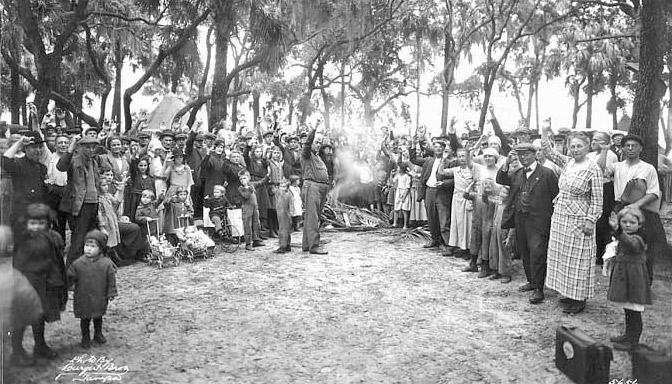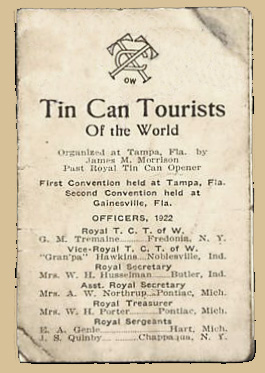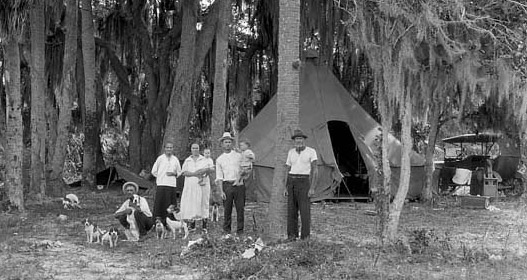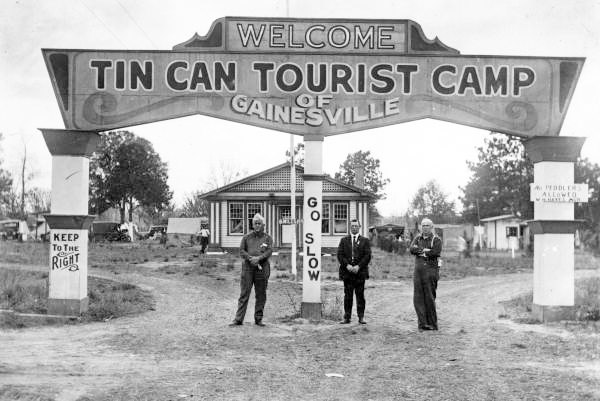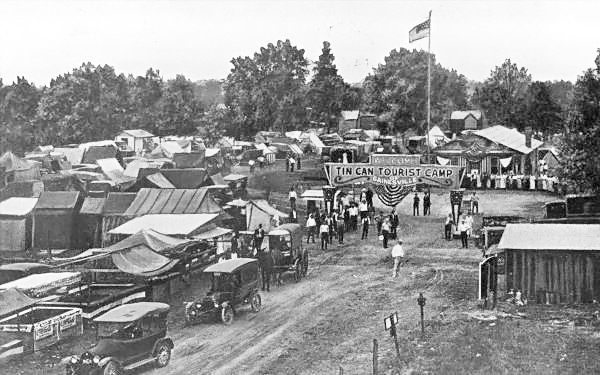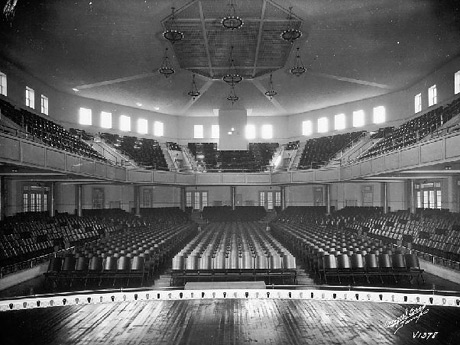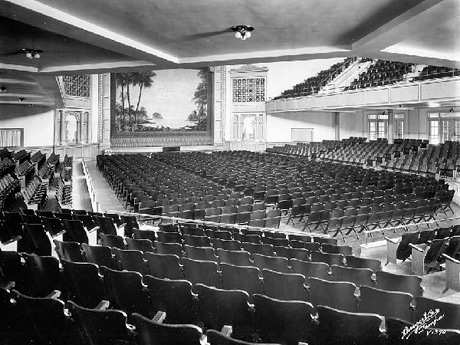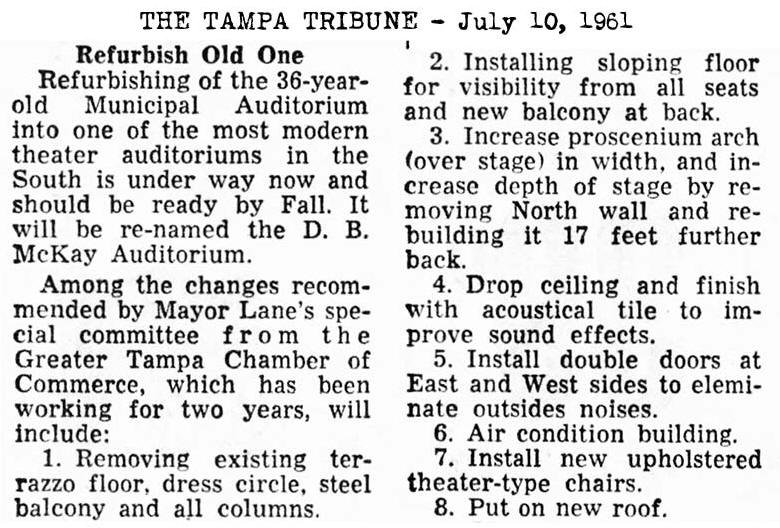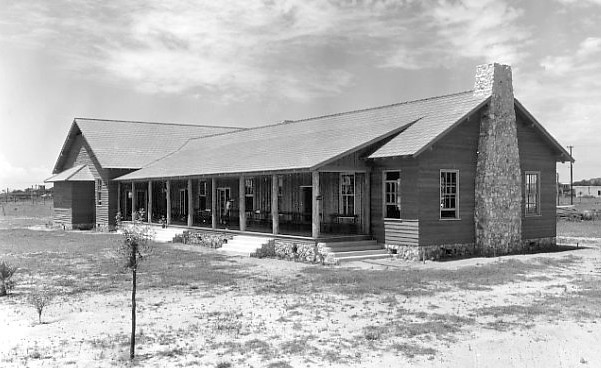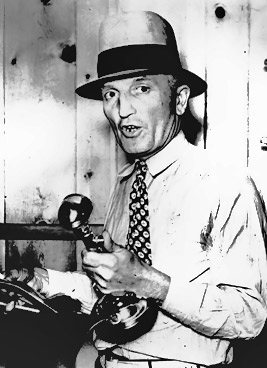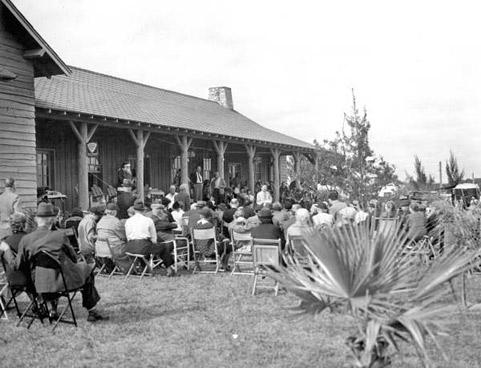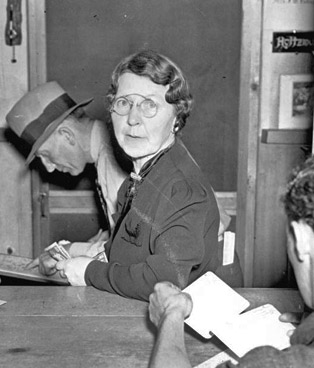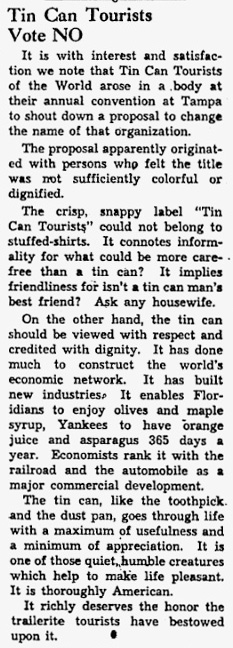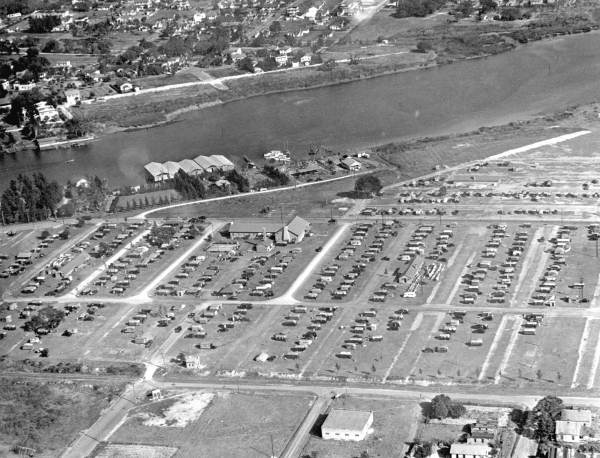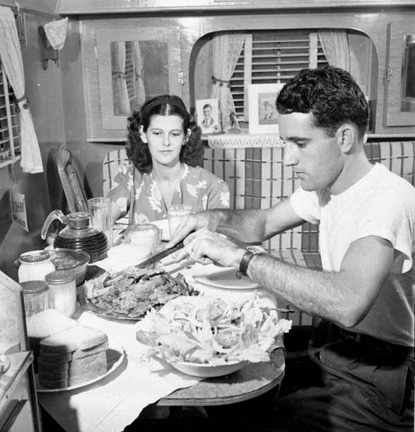|
 Tampa's Tin Can Tourists
Tampa's Tin Can Tourists

|
|

Tin Can Tourists at
Tampa's De Soto Park, 1920
Burgert Brothers, Digital
Florida Studies Center Gallery.
http://scholarcommons.usf.edu/flstud_gallery/100
|
|
The
Twentieth Century
Pioneer
With the arrival of
the 20th century, Americans continued in the pioneering spirit of their
forbearers and took to their automobiles to explore the great unknown.
Thousands of Americans packed their vehicles with their tents, an extra
5-gallon can of gasoline, lots of canned food, and a spare tire or two, and
began exploring the country in a manner not unlike Lewis and Clark.
They became the symbol of restless, adventuresome America, overflowing
with curiosity. These were the Tin Can Tourists.
These pioneers weren't travelling because of
economic hardship in search of a better source of income. These were
quite often middle-aged folks who had their fling at earning a living and
now wanted to live "the life of Riley." They were families of
retired and working Americans and Canadians, many of whom were
businessmen, lawyers, doctors, dentists, merchants, policemen, war
veterans, jewelers, and people in show business who worked in the summer.
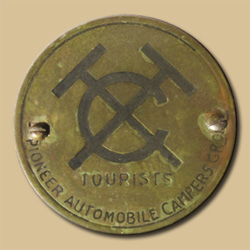 |
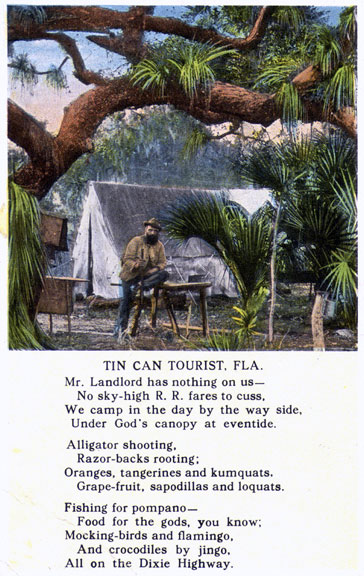
State Archives of Florida, Florida Memory,
http://floridamemory.com/items/show/158084
|
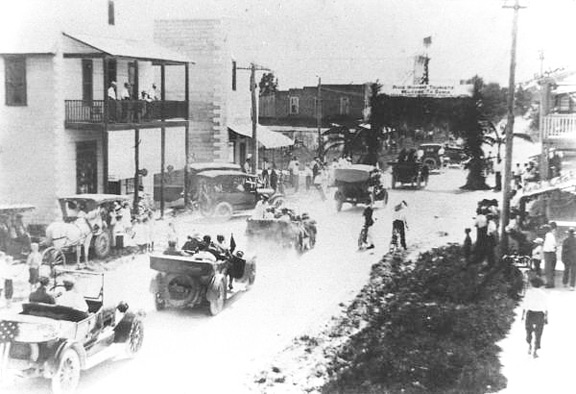 |
The
Dixie Highway Opens the Gates
After the completion of the Dixie Highway from Montreal
to Miami in 1915, the number of automobile tourists to Florida increased
dramatically every year, and Florida's rural areas and small towns began to
change as well. The 1920s featured a faith in the material growth of the
nation and with Florida’s natural allure, caused much of the state to seemingly
mushroom overnight. According to one local
historian, "it seemed that all the people of the Midwest and farming regions of
the North were coming to Florida to spend the winter in their trailers.” Lured
by the accounts of friends who had visited the area, intrigued by Florida
sunshine and sand, and spurred in the 1920s by the mobility of Henry Ford's
inexpensive cars, the numbers of immigrants to the state steadily increased. |
|
Parade celebrating
the opening of the Dixie Highway, Dania, FL 1915
State Archives of Florida, Florida Memory |
|
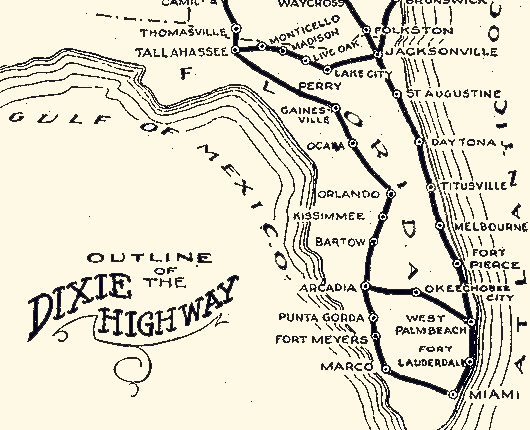
The Dixie Highway system in 1923
| The automobile and the prosperity of the nation after World War I made
possible the first great tourist invasion of Florida. The winter of 1919-20
marked the arrival of the so-called Tin Can Tourists; visitors driving homemade
mobile trailers and eating out of tin cans. Cars from all over the North headed
to Florida piled high with bedding, tents, and boxes of canned food. In no time
at all the highways leading south were crowded, and the Tin canners swarmed over
the south Florida landscape.
Celebration of the Dixie
Highway opening in Brevard County, FL.
Tin Can Tourists In Florida |
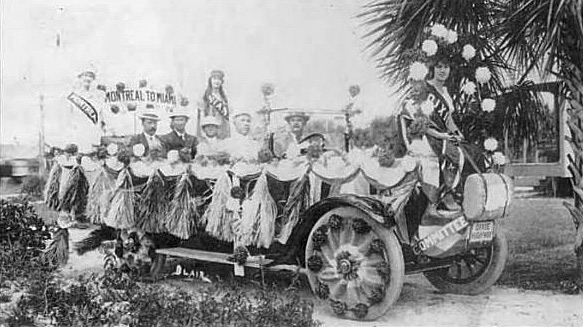 |
| |
|
|
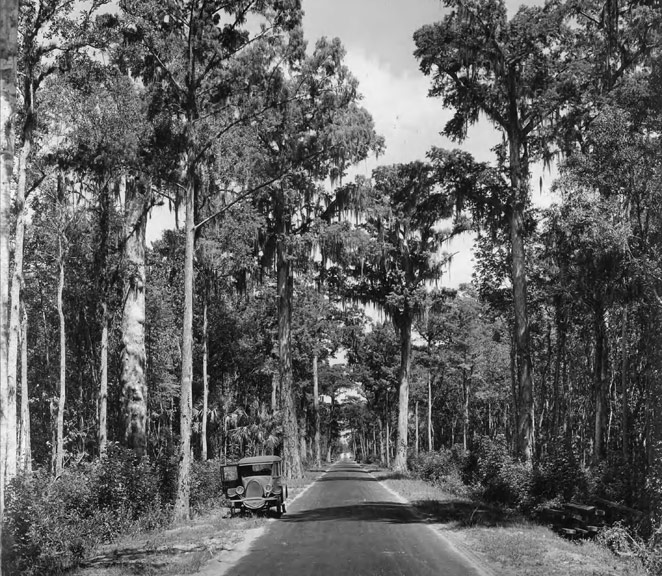
The Dixie Highway nearest to the Tampa bay
region, circa
1923
Burgert
Brothers, Digital Florida Studies Center Gallery. .
http://scholarcommons.usf.edu/flstud_gallery/167
Tin Can Tourists Take to the Roads
Even before the
organization was officially formed, the name "tin can tourist" was given to
motorists who could live for weeks or months out of their vehicles. One member
said, "The called us tin can tourists, because of our cars (Model Ts or Tin
Lizzies) and the fact that canned food was frequently on our menus." It was
common for these travelers to fill their vehicles with enough canned food
before the journey to last the duration of the trip, much to the chagrin
of restaurants and hotels. In fact, the Tin Can Tourists were notorious
around Florida for being thrifty. |
| |
|
|
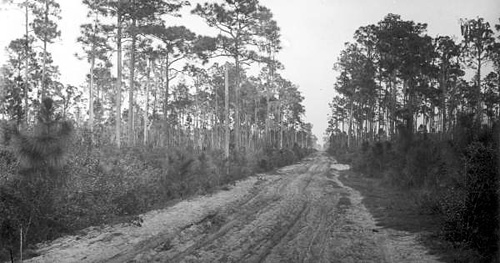
The Dixie Highway near Lakeland, circa 1917
State Archives of
Florida, Florida Memory,
http://floridamemory.com/items/show/28331
|
In Florida, the roads connecting cities and towns were little more than
deeply rutted dirt roads with very few bridges and even less places for
lodging with amenities. Tin canners who set out on the open road
often encountered fallen trees, swollen streams, swamps, and other
obstacles not much different than what the early Florida pioneers
encountered. A tin can became a sign of distress — sort
of like a road flair when hung from the radiator of a car. If somebody
passed by and was a fellow Tin Can Tourist, they would stop to help.
There was a Good Samaritan aspect to it. Flat tires were a huge problem in
the early travel days and there were a lot of other problems.
|
|
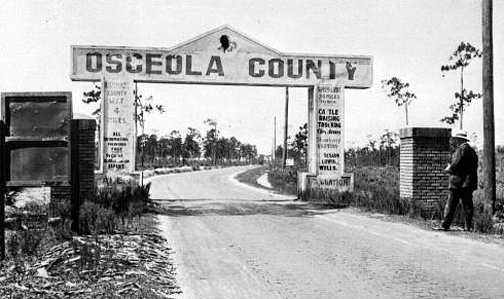
Osceola County gate on the Dixie Highway, 1920s
State Archives
of Florida, Florida Memory,
http://floridamemory.com/items/show/6871
|
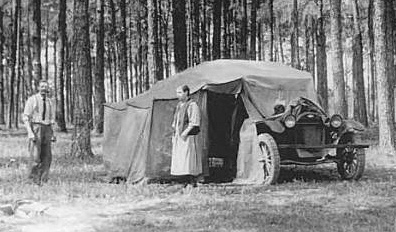
A
campground just north of Jacksonville, circa 1919
Tin Can Tourists In Florida
|
The lack of lodging
and amenities made tents the shelter of the day. Many Tin canners
incorporated their automobile with part of their tent structure, thus
making it their transportation and lodging.
All this only meant that their trek was guaranteed to be an adventure, no
matter what route they took. When Tin canners saw something of
interest, they just pulled over off the side of the road and set up their
camp.
|
|

Panoramas of Tin Can Tourists at De
Soto Park, Tampa - 1920
http://digital.hcplc.org/burgert/archiveC/1053sc.jpg
http://digital.hcplc.org/burgert/archiveC/1056sc.jpg

|
|
The
Formation of the Tin Can Tourists of the World
|
|
The Tin Can Tourists were organized at De Soto Park,
Tampa, Florida, in 1919 and received their official state charter a year later.
The association formed to coordinate the conventions of the new and
expanding practitioners of automobile-camper travel, with their
stated objective as, “to unite fraternally all autocampers”.
Their guiding principles were clean camps, friendliness among campers, decent
behavior and to secure plenty of clean, wholesome entertainment for those in
camp. The group known for the soldered tin can on their radiator caps grew
rapidly during the twenties and thirties. |
Members could be inducted by fellow campers through an
initiation process that taught the prospective member the secret
handshake, sign, and password. After singing the official song “The More
We Get Together” the trailerite was an official member of the Tin Can Tourists
of the World. an applicant had to be at least
12 years of age and of good moral character; must be living in a tent, car
house, car, trailer, or camp (tourist) cottage, on or near the site of a meeting
at the time of application for membership was made; and must apply for
membership in person. |
|
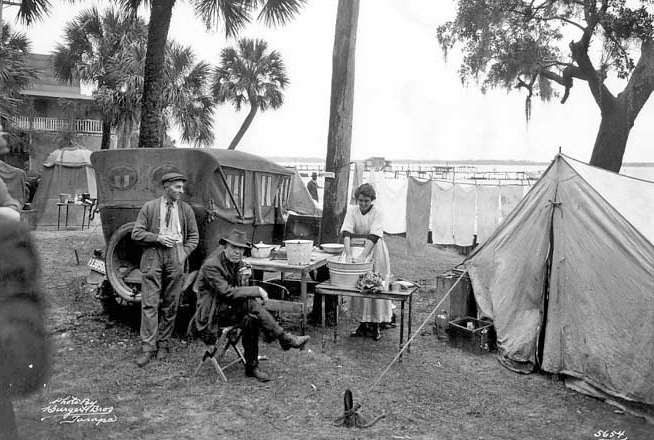
|
Membership in the organization provided a clear distinction between those
who travelled the for fun and recreation and those who travelled due to
economic hardship. It is difficult to distinguish the tin-canners of
the early 1920s from the Okies of the late 1920s in old photos. The
Tin Can Tourists organization provided the distinction. The
formation of the organization gave the Tin canners a high degree of clout.
Municipalities throughout the nation began to realize influx of seasonal
visitors to their area could help boost the local economy, so many towns
and private citizens began to develop areas to accommodate them. |
|
Tin canner men
relax while woman washes clothes at De Soto Park, Christmas Day - 1920
Burgert Bros.
collection
http://digital.hcplc.org/burgert/archive01/973.jpg |
|
De
Soto Park, Tampa
Tampa, much to its credit, provided the best
facilities available at the time at a location in De Soto Park, on the shores
of Tampa Bay. Camp sites were free, as was nightly entertainment. In the
early years, the park was little more than a clearing in the trees, but soon there was plumbing with
hot and cold running water available, and for only fifty cents weekly, children
from the camp could attend school in the Hillsborough County system.
|
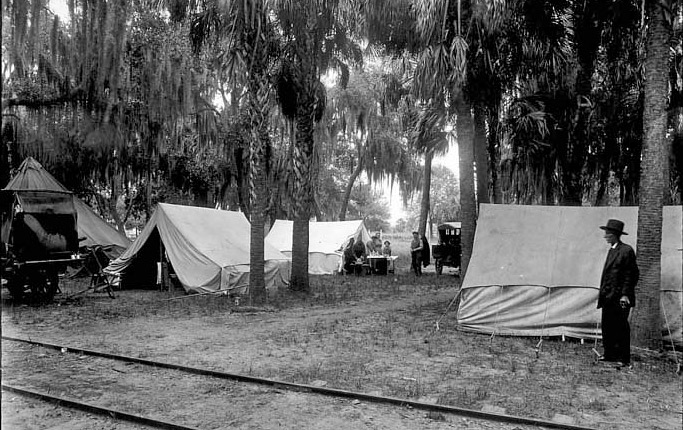 |
| |
Tin canners and their
tents at De Soto Park, 1920
http://digital.hcplc.org/burgert/archive01/965.jpg
|
|
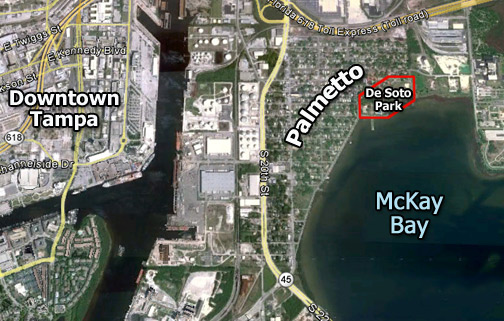
|
| |
De Soto Park is located at the northeast end of McKay Bay in Tampa (not
to be confused with Fort De Soto Park founded on Mullet Key about 1955,
in the St. Petersburg area.)
|
|
|
The Tin
Canners were the harbingers of the wild speculation of the boom years. Annual "convocations" were held for years here and in
Arcadia during the winter tourist rush. In 1921, there were approximately
17,000 members
throughout the the US and Canada. Tampa itself had a total population of
only 51,608 in 1920, and the impact of masses of tourists spurred the fantastic
speculation of the era.
|
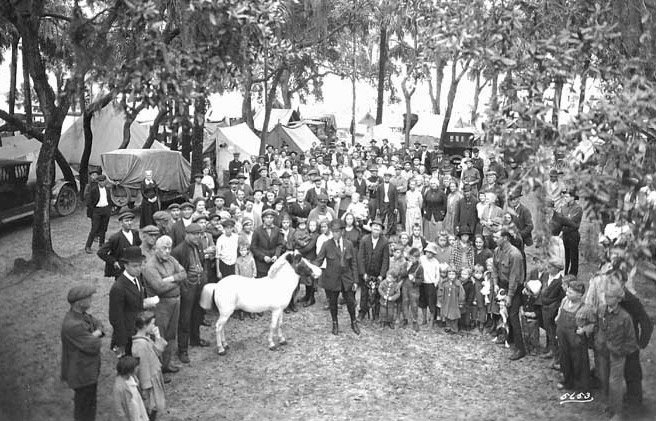 |
| |
A crowd
of Tin canners gathers around a man offering pony rides, De Soto Park,
1920
http://digital.hcplc.org/burgert/archive01/755.jpg
|
|
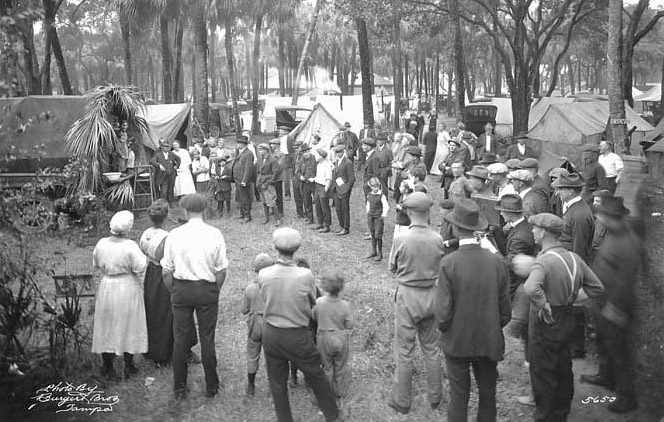 |
Throughout most of its history, the group convened for its winter meetings in
Florida and its summer gatherings in a northern locale, quite often around
Traverse City, Michigan. The main order of business at these conventions, led by
the organization's leader (appropriately named the Royal Can Opener), was to
decide where and when to stage the next convention. The rest of the time --
which for some members could last months before and after the conventions -- was
devoted to horseshoe matches, card games, baseball, and dancing. |
|
Tin canners at De
Soto Park, 1920
http://digital.hcplc.org/burgert/archive01/756.jpg
|
|
|
The
Florida Land Boom of the 1920s
|
|
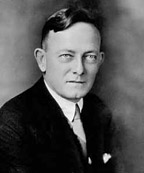 |
|
|
David Paul
Davis - 1925 |
|
|
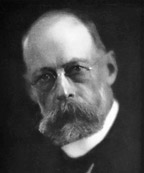 |
|
|
George S.
Gandy, 1922 |
|
The boom of the early twenties sent land values skyrocketing. Real estate
speculation was rampant and furious. In 1920 a 40-acre parcel of Florida
land sold for about $45; four years later it sold for $40,000. In the
Tampa Bay area, men such as D. P. “Doc” Davis parlayed their vision and
salesmanship into millions of dollars of profit. Indeed, on the west coast, the
newly opened Gandy Bridge symbolized the era of prosperity and development that
had engulfed the region.
On Florida’s Gold Coast the land boom was even more
explosive. Between 1921 and 1925 the payroll of the city of Miami grew 2,449 per
cent. The assessed value of property in the city jumped 560 per cent in that
same time span. The value of issued building permits skyrocketed from $4.48
million to $58.65 million. During the "Florida Boom," it was estimated that in
1925 the state spent $400 million on building construction; $50 million on
railway track and equipment; and $7.5 million on 286 miles of new state highway.
Moreover, tourists spent $250 million in Florida during the 1924-25 winter
season. This cycle of gambling, greed and glut continued until the Florida land
boom bust in 1926. |
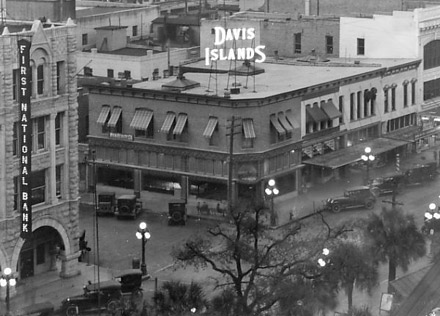
Davis Islands land office on Franklin
St., 1925
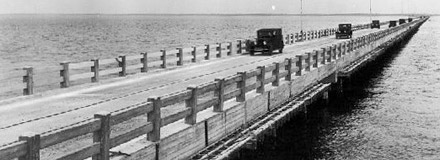
Gandy Bridge Completed, 1924 |
|
See
Tampapix feature
D.P. Davis
and his Islands |
See
Tampapix feature
The Gandy
Bridge, First to Span Tampa Bay |
| The main
thoroughfare through De Soto Park was named "Easy Street" by the Tin
canners. This way, they could legitimately write home to friends
and family that they were in Florida, living on Easy Street.
Charles T. Falles,
known as the "Mayor of Easy Street,” was the organization’s first Royal
Sergent.
Tin Can Tourists In Florida |
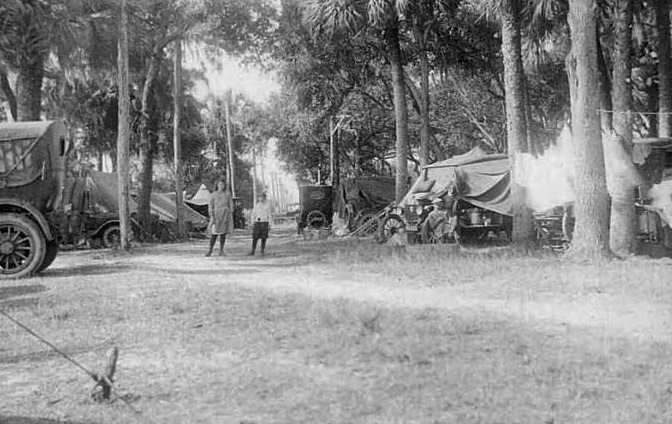 |
| |
|
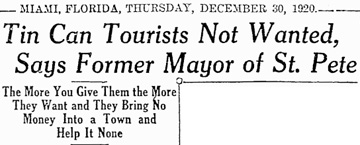 |
Former St. Pete mayor Al Lang had an axe to grind with the Tin Can
Tourists and referred to the 1920 campers as "undesirables" and
criticized them for starting a grocery store on city property, in
competition with local merchants. He advised Miami to "lay off
catering to this class of tourist" and said "they are of no benefit to a
town whatsoever."
Read the entire article |
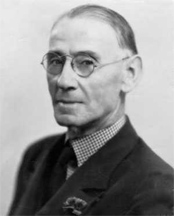 |
| Al Lang, mayor from
1916 to 1920, lured the first baseball teams to train in St. Petersburg,
starting with the St. Louis Browns in 1914. "Before Al Lang came along,
St. Petersburg was viewed by baseball as little more than blip on the
map," wrote author and baseball historian Wes Singletary. "He changed
all that." Baseball had already discovered Florida in 1888 when the
Washington Nationals began training in Jacksonville. The Chicago Cubs
discovered Tampa in 1913. But Lang wanted the sport in St. Petersburg,
believing it would boost tourism. He died in 1960 at age 89.
Remembering Al Lang, St. Pete's Mr. Baseball |
De Soto Park Closed to Tin Can Tourists
|
|
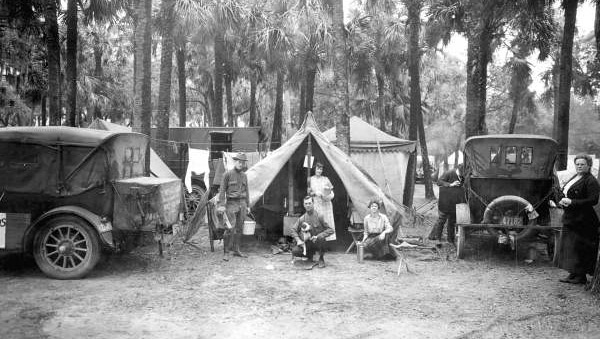 |
Summer reunions for the Tin Can Tourists were held at
various Midwest locations, with Traverse City, Michigan serving as a primary
host city. The club spent winters at Desoto Park in Tampa until 1924. Many native Floridians did not welcome the vagabond
travelers with open arms -- in 1924, Tampa locals
grew tired of their park being overrun with northerners and
forced the closing of DeSoto Park to rid the city of the Tin Can Tourists
shortly after the group was formed. Yet, the organization continued
to flourish. The canners took the hint and moved
the Winter Convention to Arcadia, where the community had built a municipal park
especially for the Tin Can Tourists. |
|
Tin canners and their
dog at De Soto Park, Christmas day, 1920
Burgert Bros. Collection
http://digital.hcplc.org/burgert/archive01/972.jpg
|
|
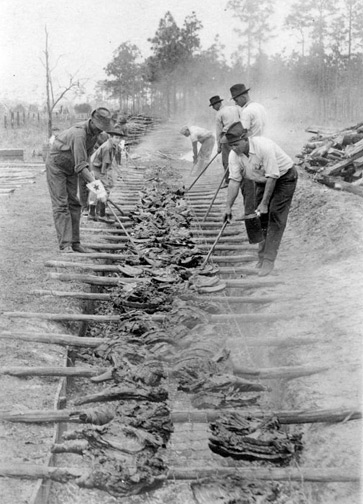 |
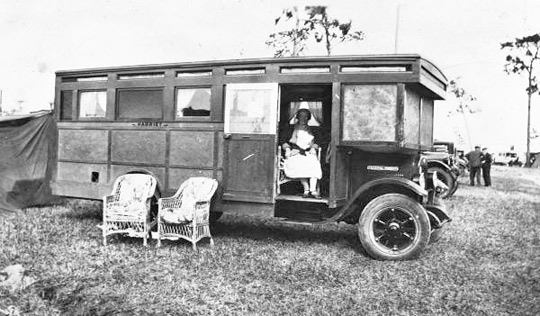 |
|
Above: House car named Harriet at Tin Can Tourists convention:
Arcadia,1929 Harriett belonged to Mrs. Harriett Warren, Mrs. Flora
Kavanaugh, and Westel Ashe, all of Brattleboro, Vermont.
State Archives of Florida,
Florida Memory,
http://floridamemory.com/items/show/138293
Left: Preparing BBQ at Aracadia Tin Can Tourist convention, 1920s
State Archives of Florida, Florida Memory,
http://floridamemory.com/items/show/33794
|
| |
|
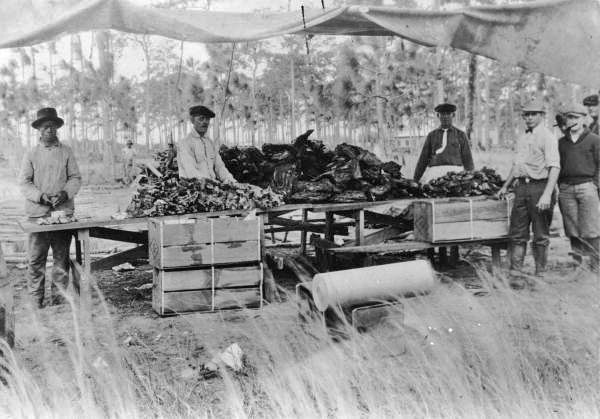
BBQ buffet at the
Arcadia convention, 1920s
State Archives of Florida,
Florida Memory,
http://floridamemory.com/items/show/33797
|
Royal Chief Otho Granford Shoup at
Gainesville, 1922
Otho G. Shoup was
born around 1868 in Pennsylvania and grew up in Scranton. He then
moved to Detroit around 1909 where he worked as mason and contractor for
Interstate building and Land Co. until around 1923. By 1925, he
and his wife Rose had settled in Gainesville, FL, where they lived until
at least 1945.
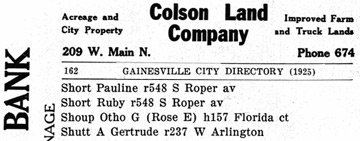 |
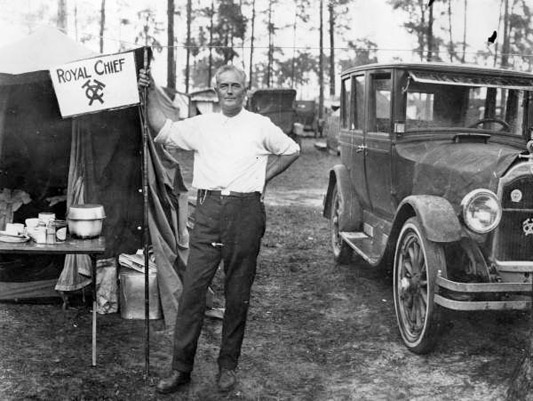 |
| |
State Archives of
Florida, Florida Memory,
http://floridamemory.com/items/show/1210
|
| Tin Can
Tourists in Gainesville, circa 1922. Seated in front of the
table on the right is Otho Shoup. To the right of him is his
wife, Rose.
State Archives of Florida, Florida
Memory,
http://floridamemory.com/items/show/1212
|
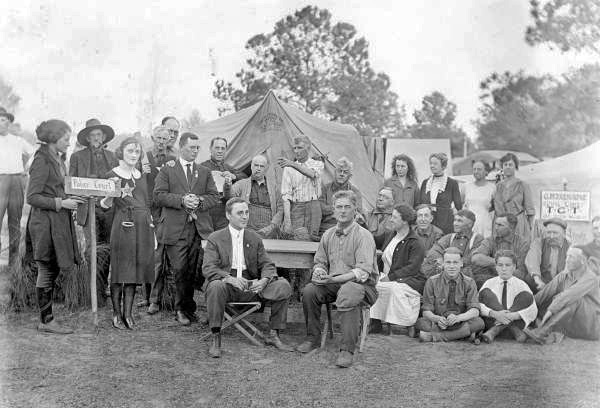 |
| |
|
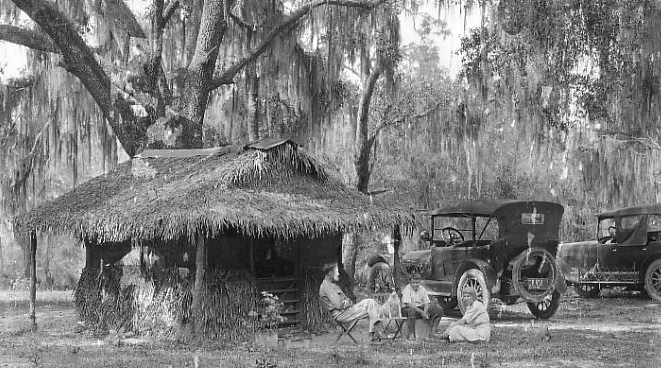
Thatched hut at a campsite in Palmetto,
1922
Palmetto is the area located just west and southwest of De Soto Park,
bordered on the west by 22nd St. and on the north by Adamo Drive
http://digital.hcplc.org/burgert/archive06/5884.jpg
|
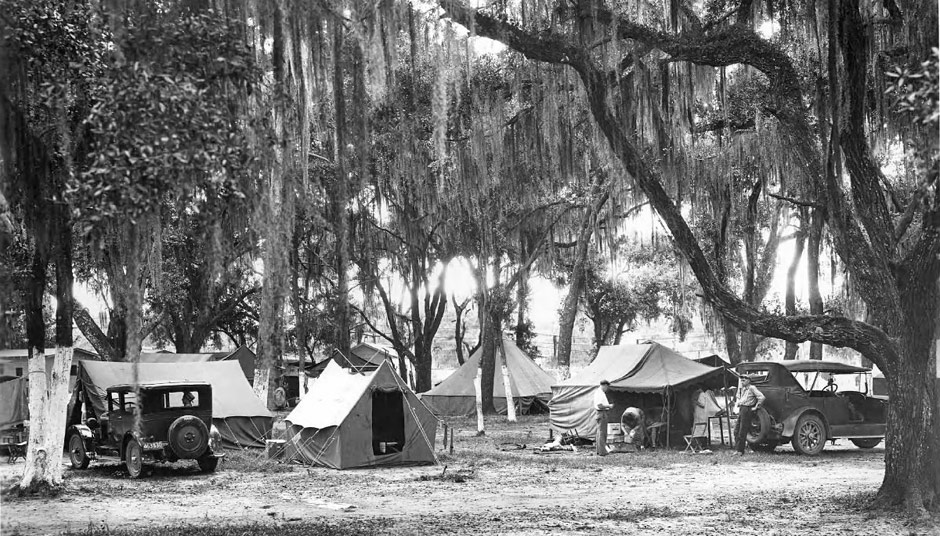 |
|
Tin
canners at
Suniland Magazine Tourist Camp, Six-Mile Creek in 1925
Burgert
Brothers, Digital Florida Studies Center Gallery.
http://scholarcommons.usf.edu/flstud_gallery/216
Six
Mile Creek
| |
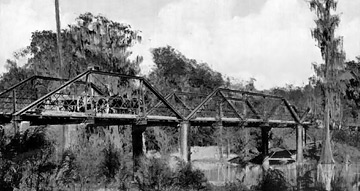 |
| |
Bridge over
Six-Mile Creek, circa late 1890s |
Hillsborough County's
Palm River is south of State Road 60 / Adamo Drive and flows into McKay
bay south of Ybor City. Upstream, the Palm River bends towards the north
and was called Six Mile Creek. Here was where Plant's railroad first
entered the area. In the first half of the 20th century if you were
traveling into Tampa from Brandon, Plant City, Lakeland or any other
community to the East you had to travel down Broadway over an old bridge
spanning Six Mile Creek. Surrounding the bridge was the small community
of Six Mile Creek that contained a market and service station ready to
meet the needs of travelers. When settlers first came to the area they
set up farms along the creek and river. As the area grew industrial
factories began to set up shop near the creek and river shores.
See "Tampania" website, "Palm River--Burying Our Past."
|
|
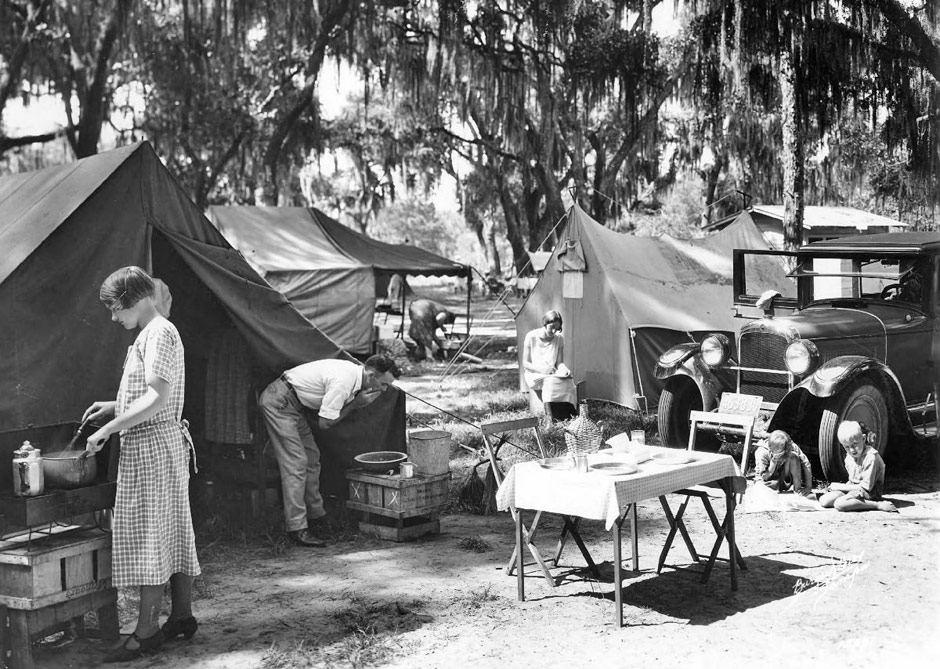 |
|
Suniland Magazine Tourist Camp Tin
canners at Six-Mile Creek in 1925
Burgert Brothers, Digital Florida Studies Center Gallery.
http://scholarcommons.usf.edu/flstud_gallery/217
|
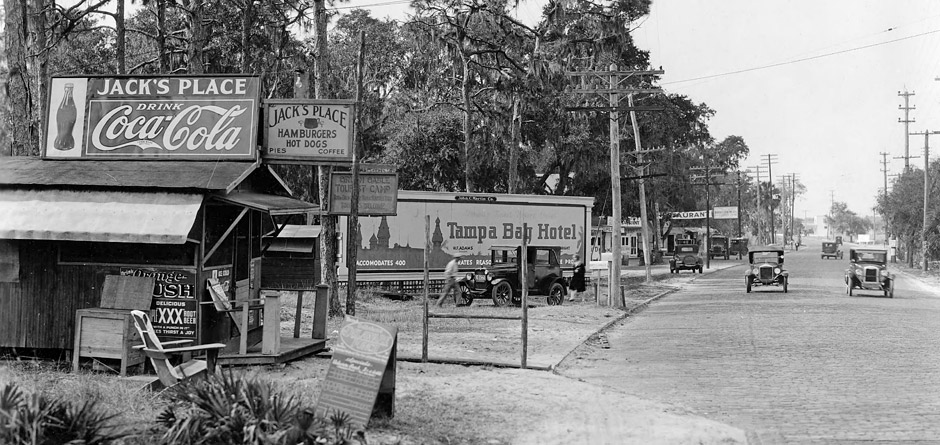
Jack's Place, Green Gable Tourist Camp &
the Oaks Restaurant, Tampa - 1927
Burgert Brothers, Digital
Florida Studies Center Gallery
http://scholarcommons.usf.edu/flstud_gallery/273
Conventions Gain Popularity
The
Tin Can Tourists conventions grew in size and began to include
commercial vendors coming from points throughout the country. By the early
1930s, Florida communities recognized the impact of the tourists -- even Tampa
city officials begged the group to return. Though one of the rules of being a
Tin Can Tourist was that a member couldn't own property in Florida, the group is
said to have had a significant impact on the booming land development in the
state. Many snowbirds would decide to stay permanently, while others returned to
their homes in the Midwest with wonderful stories about the Sunshine State. |
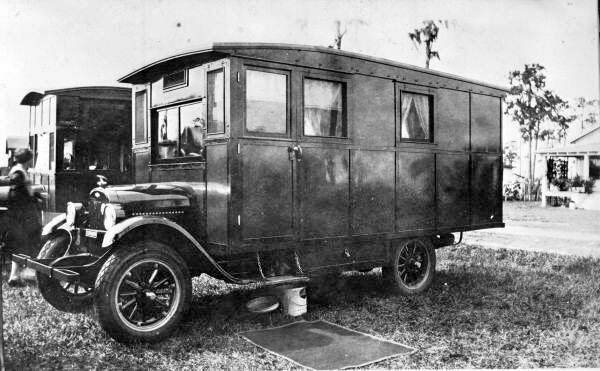 |
| |
Housecar from
Minneapolis at the Arcadia convention, 1929
State Archives of
Florida, Florida Memory,
http://floridamemory.com/items/show/138299
|
|
The annual trek,
fueling the twin industries of tourism and real estate, suffered during
the depression years. But by 1932, with membership
on the increase, city Chambers of Commerce were actively pursuing Tin Can
Tourists to choose their community for either Homecoming, Winter
Convention or Going Home meets. The Winter Convention was the best
attended and was an economic boon to the host community. |
|
|
|
Sarasota's
Convention Bid
It was not until 1932 that Sarasota hosted the winter
convention of the Tin Can Tourists. In 1931, Mayor E.A. Smith and
other community leaders decided to lure the annual TCT convention away from
Arcadia, where it had been conducted for a number of years.
|

Tin canners at Payne Park, Sarasota,
1936
State Archives of Florida, Florida Memory,
http://floridamemory.com/items/show/138290
|
A motorcade of nearly 250 cars drove from Sarasota to Arcadia, parking in
the camp. Carrying banners inviting the TCT to Sarasota, community leaders distributed free copies
of the Sarasota Herald and gave speeches promoting the change in venue. The
Sarasota Bay Post 30 American Legion Band presented a concert to the 2,000
campers. When the vote was counted, Sarasota had won the contest. The vote on the Winter Convention site was hotly contested. Many Canners
were loyal to Arcadia, the town that wanted them after their ejection from
Tampa. As a concession to those that favored Arcadia, it was designated as the
official site for Homecoming festivities.
|
|
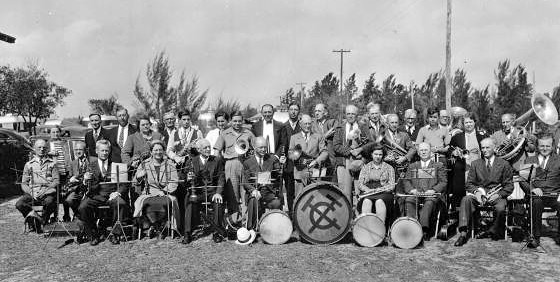
Tin Can Tourists band in Sarasota,
circa 1941
Florida Memory,
http://floridamemory.com/items/show/138288
|
Their arrival in January was headline news for the city
that had fallen on hard economic times: “SARASOTA WELCOMES TCT FOLK.” For the
locals still suspect of the group, given its Tin Can name, Royal Chief R.W.
Vaughn informed them that the group was made up of respectable people from all
walks of life: doctors, lawyers, manufacturers, preachers and bankers and noted
that they “spent hundreds of thousands of dollars every year for gasoline, oil,
tires, new cars, motor repair and upkeep.” The group gathered annually around
Payne Park, and their community later morphed into the Sarasota Mobile Home
Park. |
|
By 1938 the organization had grown to approximately 30,000 members and
incorporated as Tin Can Tourists of the World.
More than 3,000 “nomads” from 45 states, Canada and two foreign countries
poured into Sarasota. Several thousand
campers attended each year and participated in a variety of activities. The
annual TCT parade along Main Street included trailers from the modern to the
historic, floats representing the camper's home states, clowns and a number of
bands.
In 1938, the
mayor of Sarasota indicated that the national perception that Sarasota was a tin
can tourist’s town was hurting the community and that he would not renew the
Winter Convention contract. |
Tampa
Wants Tin Can Tourists to Return
|
|
In mid April of 1939, 300 to 400 operators of Florida tourist parks met in Tampa Municipal
auditorium for its 2nd annual program to
discuss matters of vital importance to the cottage and trailer park industry,
under the supervision of William Tusz, owner manager of Camp Nebraska in Tampa.
Tampa Municipal Auditorium was built in 1926 behind Plant Hall on the
University of Tampa campus. A few years afterward, prominent Tampan D.B. McKay died.
In 1960, the building was renamed McKay Auditorium in his honor. A 1993 fire left it gutted
and unusable. In 1997, local computer entrepreneur John Sykes donated
$10-million to the University of Tampa, and most of the funds were used to refurbish and
expand the damaged neoclassical structure into the John H. Sykes College of
Business, which opened in 2000.
|
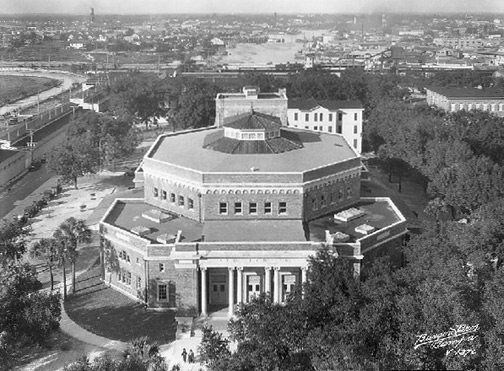
http://digital.hcplc.org/burgert/archive01/203.jpg
|
|
Monument
Rises With New Name |
Tampa Municipal Auditorium in 1926 |
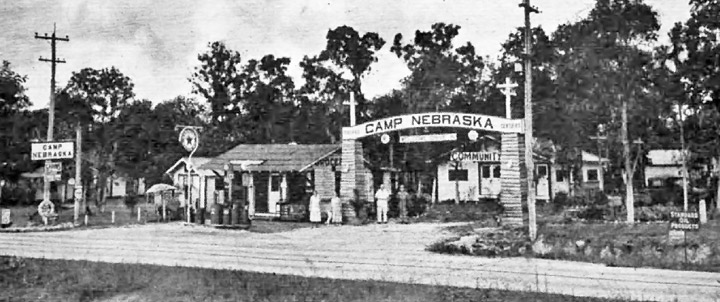
Camp Nebraska at 10314 N. Nebraska Ave. in
Tampa
USF Special Collections, Burgert Bros.
http://digital.lib.usf.edu/?d32.595
Watch these videos:
Travel Trailer Life in 1937 Florida Snowbird Park
Blue Sky Barber Shop
Tin Can Tourist Cartoon
|
Tampa
Municipal Tourist Camp
Tampa then offered the tin-canners a five-year deal to
return to Tampa. It was accepted and the Winter Convention returned to specially
built Tampa Municipal Park in 1939.
In 1938-39, Tampa municipal
tourist camp opened at 2300 N. Oregon Ave. to host the 1939 convention.
Managed by Fred W. Holtzman with his wife, Violet Holtzman as "Hostess", the
park was located along the west bank of the Hillsborough River just south of
Columbus Drive, bordered by Rome Ave. on the west and Spruce St. on the south.
The 1945 Tampa street
map shows the location of Tampa Municipal Tourist Camp. |
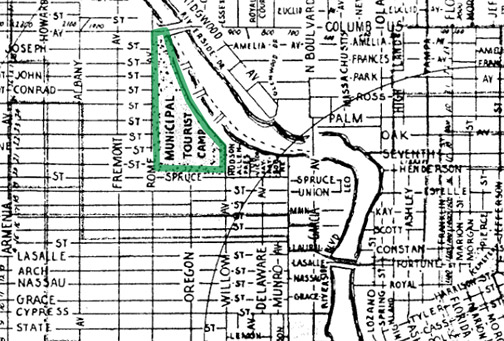 |
| |
See
this area today
|
|
Their brochure advertised "Tampa's newest and finest trailer park offers you
spacious lots with 24-hour electric and water service. There are modern
and complete restrooms with steam heat, holt and cold showers, a large laundry
with electrical equipment, city water and sewerage service." Two persons
per day paid 35c a day or $1.50 per week. Extra persons were 10c a day or
25c per week. Electric rates were 15c a day or 60c per week for a 3 amp
hookup and 25c per day or $1.00 per week for a 6 amp hookup. In the rare
event the Tampa winter was cold enough to need heat, a 15 amp heater could be
purchased at 50c per day or $2.50 per week.
Click the brochure pages to see them
larger
State Archives of Florida, Florida
Memory,
http://floridamemory.com/items/show/35905
http://floridamemory.com/items/show/35906
|
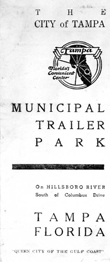 |
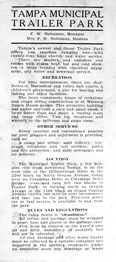 |
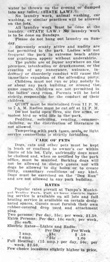 |
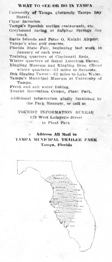 |
| The park had facilities for shuffleboard, horseshoes, volleyball, a
children's playground, and a pier for boating and fishing. In the large,
Western Ranch style community house there was a card and game room, a large
dance floor and stage, a reading room and the camp office. Services
included a post office, mail delivery, telegraph, telephone and taxi services,
police and fire protection, daily newspaper and ice delivery. |
|
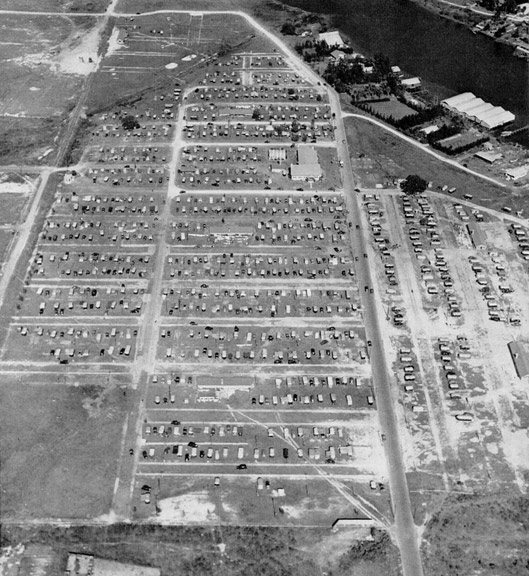 |
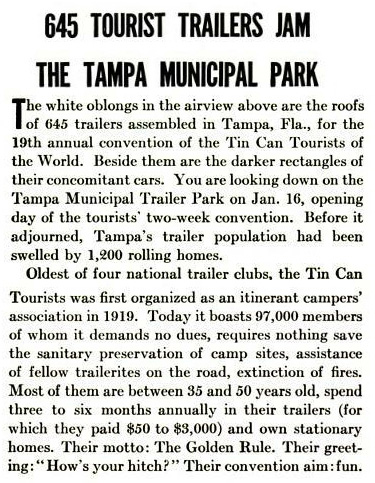
LIFE Magazine, 1939 |
| |
|
| The group soon faced
membership declines due to combination of factors. A division within
the ranks of the Tin Can Tourists, the formation of ATA, the Automobile
Tourists Association, an economic recession in 1939 that greatly
diminished the number of trailer manufactures, and the onset of World War
II. |
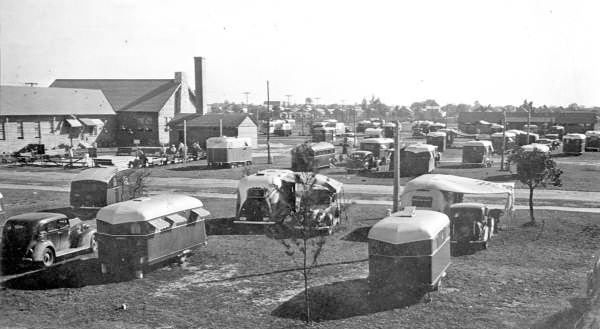 |
| |
1939
State Archives of
Florida, Florida Memory,
http://floridamemory.com/items/show/35904
|
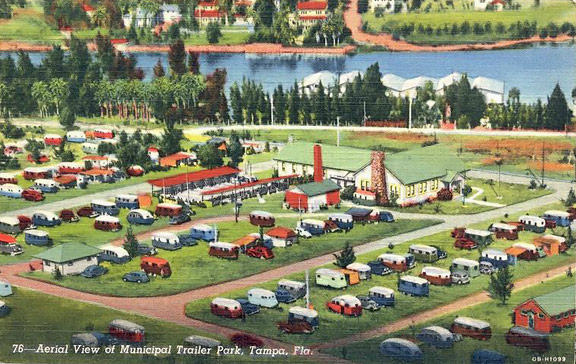
Postcard circa 1939
In 1942, the 22nd annual
meeting of the Tin Can tourists was expected to bring 2,000 trailers with
6,000 tourists from Feb 16 to Mar 2.

Municipal Trailer Park Tin Can
Tourists convention, 1942
Tin Can Tourists Rolling History
Click to see larger
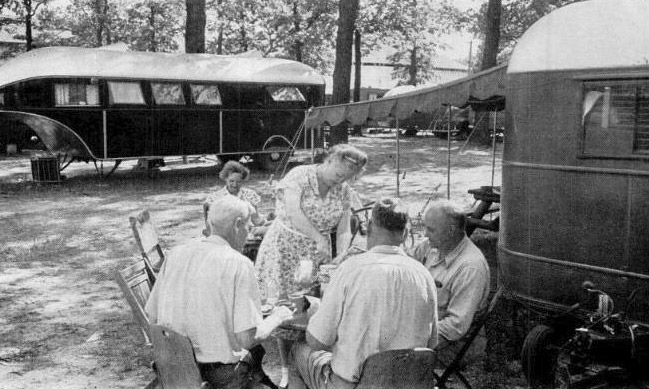 |
Post-War Tin Canners
After World War II, more and more Americans took to the open road to explore
the nation and spend vacations in their vehicles. Although the increasing number
of hotels and resorts eventually caused a decline in camper-traveling,
ever-more-sophisticated trailers and campers allowed people more comfort and
convenience as they sought to combine leisure with their love of traveling.
Winter Convention photographs depict a smaller group in 1948 at Tampa.
By this time, the park was managed by Hal and Ann Carder.
|
|
Mrs.
Charlie Treffert serves refreshments to fellow Tin canners at Tampa
Municipal Trailer Park, 1948 |
|
Typical Tin Can Tourists
In 1948, the Tin Can Tourists of the World members
numbered 80,000 strong. Cities clamored to host the convention with hopes
of netting the $200 to $300 a month each Tin canner spent. Typically,
Tin canners were around age 50 to 65 and either had no children or had grownup ones
Families of two owned 61% of the trailers. Families of three and
four, 38% and larger families, the remaining 1%. The sentiment of
the majority of older trailerites was that a trailer camp was not the
right atmosphere for children. Most parks had an area designated for
families with children, but families with dogs were not zoned. A
considerable percentage were retired farmers, policemen, firemen, and civil
servants, living on pensions or the rent from houses they own.
|
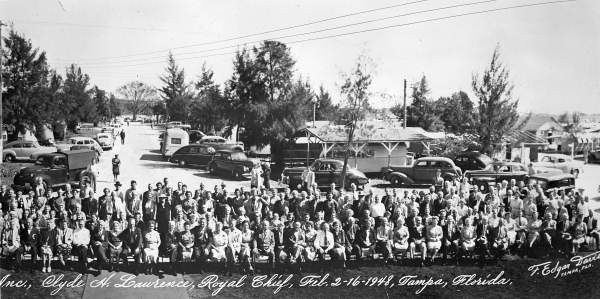 |
|
25th annual
convention at Tampa Municipal Trailer Park, 1948 |
|
The
average joint annual income of married trailerites was around $3,000.
Some of their income came from government bonds, purchased while still
working a job. They spent very little time in their hometown and
3/4ths of them prefered their trailer to a permanent home. With the
first hint of cold weather, they headed for Florida and returned back up
north around May. "True trailerites" were mobile and referred to
permanent residents who removed their wheels as "squatters." At the
1948 convention, about a third of the 1,600 trailers were "squatters."
Gambling, drinking and rough language were considered to be not in keeping
with Tin Can Tourists' ideals of social behavior. |
|
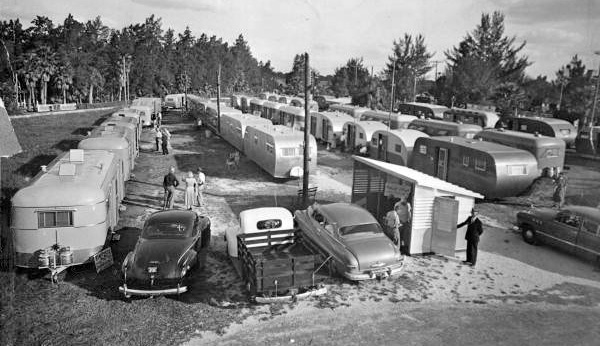 |
Trailer manufacturers took advantage of annual conventions and other
events to show off their new products, such as seen here in Tampa,
1949.
|
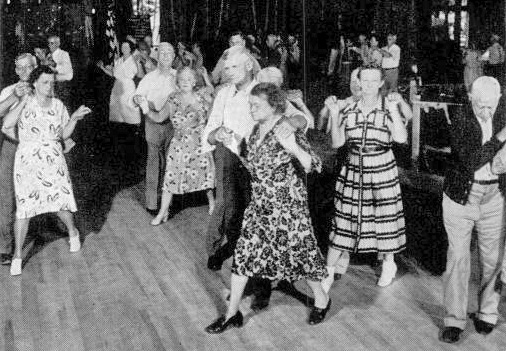 |
Wednesdays and Saturdays were dance nights at the park. The
military schottische, a favorite among trailerites, is a lively group
dance seldom seen outside of trailer park circles.
Listen to a sample of
the Military Schottische
In addition to the
Tin Can Tourists conventions, Tampa Municipal Trailer park hosted many
events through the years. In early April, 1954, the 2nd annual Florida Square and Folk Dance Festival,
sponsored by the Tampa Recreation Dept. and Florida Square Dance Callers and
Teachers Association was held in Tampa with one night featuring a
dance in the
Municipal Trailer Park gym where callers from 21 state areas presented their style. The grand
climax of the 3 day event was a mass square dance at Plant field with over 1,000
dancers expected. The Rockhounds of Tampa Bay Mineral and Science Club
held their event there 1957. |
| |
|
|
Tampa Municipal Trailer
Park was still hosting the annual Tin Can tourist gatherings in March of
1966 when the
43rd annual convention of the Tin Can Tourists of the World held
its two-week long session there. The Royal Chief of the club was Richmond
Chapin of Traverse City, Mich. In 1966 it was held in Ocala.
The Gym and Auditorium was used throughout the year for other events: Gradually, these tourist camps began to diminish in importance as small and
affordable motels replaced them in the 1950s and 1960s.
According to the club's bookkeeper, membership in the
association peaked at 100,000 in 1963. Exactly when or why the group
disbanded is unknown. |
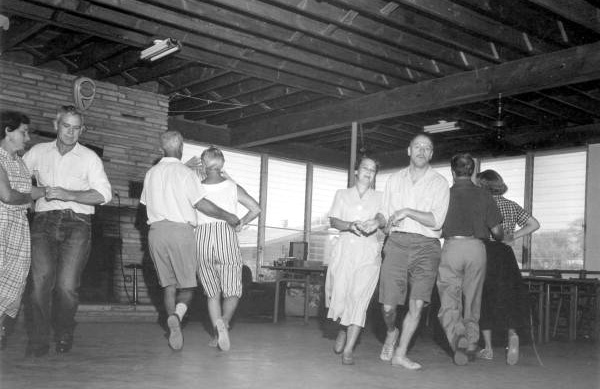
Square dancers in Sarasota, 1957
State Archives of Florida, Florida Memory,
http://floridamemory.com/items/show/57175
|
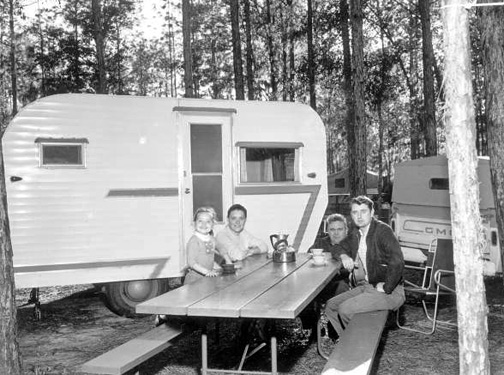
Campers in Thonotosassa, 1961
State Archives of Florida,
Florida Memory,
http://floridamemory.com/items/show/78504
|
The
Final Tin Can Tourists Convention
By the mid 1970s and 80s, the towed house
trailer was replaced by the all-in-one recreational vehicle, or "RV."
As the number of Tin Can Tourists dwindled in the 1960s and 1970s, the
original club’s last winter reunion took place in 1978 at Eustis RV Park,
Eustis, Florida. |
|
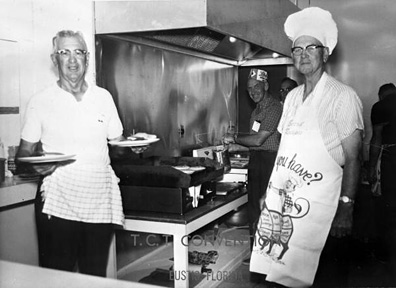 |
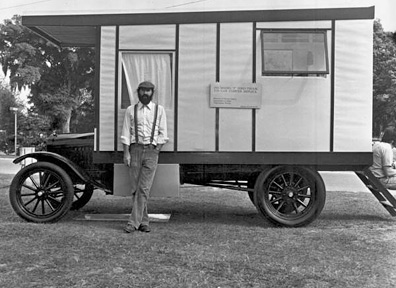 |
|
Harry McDonald, Jim
Flannery and Foster Little at Eustis, FL 1979
State Archives
of Florida, Florida Memory,
http://floridamemory.com/items/show/138276
|
Kermit Brown of the Museum of
Florida History with his home-built 1923 Model 'T' Ford truck Tin-Can
camper replica, 1979 at the 56th annual convention of the Tin Can
Tourists in Eustis, FL
State Archives
of Florida, Florida Memory,
http://floridamemory.com/items/show/155158
|
Tin Can
Tourists Resurrected
The Tin Can Tourists of
the World then experienced a 20-year hiatus that ended in 1998 when Michigan
high school teacher and coach Forest Bone and his wife, Jeri, resurrected
the organization. The reconstituted Tin Can Tourists’ first gathering
in 1998 in Milford, Michigan, drew 21 units. Their 2010 Winter Convention on
Feb. 25-28 at Lake Manatee State Park east of Bradenton drew 50 RVs and
about 120 people on a first-come first-serve basis due to site restrictions.
At the beginning of 2010, the club had 834 remembers, down from just over
1,000 at the start of 2009. The downturn was attributed to gas prices and
the economy, but membership was returning. The Tin Can Tourists 12th
Annual Gathering at Camp Dearborn in Milford, Mich., was held in May of
2010, along with two other regional gatherings scheduled that same weekend
in New York and New Mexico.
|
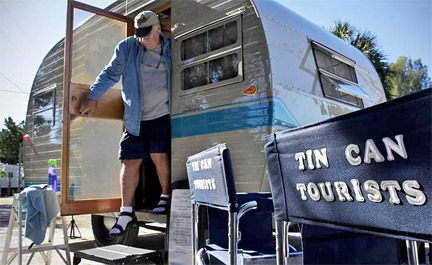
Foresst Bone and his 1955 Trotwood trailer
at Cedar Key on Jan. 27, 2010
Tin Can Tourists: Travelers to embrace friendship, trailers |
|
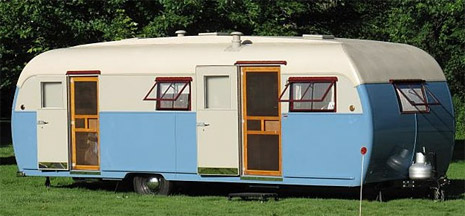
BetterRVing.com |
In addition, three other local gatherings were planned in 2010 in Michigan
and three in Florida while regional rallies were planned in Canada,
California, Washington, Arizona and New York. Today, Tin Can Tourists
typically own vintage units but it's not required. Still, 75% of Tin Can
Tourist members own vintage trailers. Shasta, Serro Scotty and Airstream
brands are popular. There are lots of ‘canned ham’ trailers that look like
Shastas that were manufactured in the ’50s. The cost of membership in
Tin Can Tourists is minimal — only $20 a year. And more than 800 members are
led regionally by seven representatives in North America and others in the
United Kingdom and Japan who provide input to the organization and run Tin
Can Tourists get-togethers
|
|
From
Camps to Trailer Parks
The fondness of many of Florida's millions of
visitors and new residents for leisurely accom-modations and vacationing helped
establish new communities that catered to people looking to stay for extended
periods without living in one location year-around. Still other places, such as
trailer parks, offered both the chance to put down roots and to pick up stakes
and move on when the time was right.
|
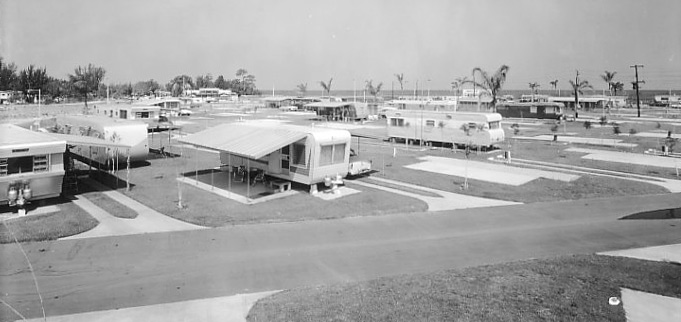
Guernsey City Trailer Park, 4851 Gandy
Blvd. - 1956
Burgert Bros. Collection
http://digital.hcplc.org/burgert/archive08/7191.jpg
|
| Florida
is a state well-suited for those who choose impermanence as a lifestyle.
In some cases, however, trailer parks and resort camping areas became so
well-established that they constituted new towns in themselves. Florida
cities that experienced tremendous growth, prosperity and popularity as
vacation and relocation destinations, such as Sarasota, also benefited
from their trailer parks which helped draw visitors and new residents.
Trailer parks proved particularly attractive areas for the thousands of
retirees that annually chose Florida as their new homes. Successful parks gained
enough population and established enough infrastructures to be incorporated as
distinct towns. Trailer parks also provided necessary housing for the droves of
new workers brought to areas of Florida transformed by new industries such as
Cape Canaveral, the center of United States space-age development in the late
1950s and 1960s.
|
645 Tourist Trailers Jam the Tampa Municipal Trailer Park LIFE Magazine Jan 30, 1939 issue
RVBusiness.com - Tin Can Tourists Celebrating 91st* Year in 2010
Tampa Bay History, Vol 14 # 1 The Carousel of Progress,
Palmetto
Tampa Bay History Vol. 15 #2 "Mass Culture Meets Main
St."
Tin Can Tourists: Travelers to embrace friendship, trailers
Tin Can Tourism
- Florida Memory Project photo exhibt
The Road to Enlightenment - Tin Can Tourists History
People in Trailers Dec. 13, 1948 LIFE Magazine
Traveling to Paradise: Tin Can Tourists on Parade
How Sarasota Lured the Tin Can Tourists
The Tale of the Tin Can Tourists
Tin Can Tourists In Florida
Videos
Travel Trailer Life in 1937 Florida Snowbird Park
Blue Sky Barber Shop
Tampapix Home
 Tampa's Tin Can Tourists
Tampa's Tin Can Tourists
















